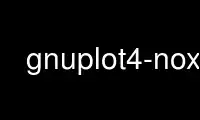
This is the command gnuplot4-nox that can be run in the OnWorks free hosting provider using one of our multiple free online workstations such as Ubuntu Online, Fedora Online, Windows online emulator or MAC OS online emulator
PROGRAM:
NAME
gnuplot - an interactive plotting program (no-X version)
SYNOPSIS
gnuplot [options] [file ...]
DESCRIPTION
Gnuplot is a command-driven interactive plotting program (no-X version).
If file names are given on the command line, gnuplot loads each file with the load
command, in the order specified, and exits after the last file is processed. If no files
are given, gnuplot prompts for interactive commands.
Here are some of its features:
Plots any number of functions, built up of C operators, C math library functions, and some
things C doesn't have like **, sgn(), etc.
User-defined constants and functions.
All computations performed in the complex domain. Just the real part is plotted by
default, but functions like imag() and abs() and arg() are available to override this.
Many presentation styles for plotting user data from files, including surface-fitting,
error bars, boxplots, histograms, heat maps, and simple manipulation of image data. There
is an on-line demo collection at
http://gnuplot.info/demo
Nonlinear least-squares fitting.
2D and 3D plots with mouse-controlled zoom and rotation.
Shell escapes and command line substitution.
Load and save capability.
Support for a huge variety of output devices and file formats.
OPTIONS
-p, --persist lets plot windows survive after main gnuplot program exits.
-d, --default settings. Do not read from gnuplotrc or ~/.gnuplot on entry.
-e "command list" executes the requested commands before loading the next input file.
-h, --help print summary of usage
-V show current version
ENVIRONMENT
A number of shell environment variables are understood by gnuplot. None of these are
required.
GNUTERM
The name of the terminal type to be used by default. This can be overridden by the
gnuplotrc or .gnuplot start-up files and, of course, by later explicit "set
terminal" commands.
GNUHELP
The pathname of the HELP file (gnuplot.gih).
HOME The name of a directory to search for a .gnuplot file.
PAGER An output filter for help messages.
SHELL The program used for the "shell" command.
FIT_SCRIPT
Specifies a gnuplot command to be executed when a fit is interrupted---see "help
fit".
FIT_LOG
The name of the logfile maintained by fit.
GNUPLOT_LIB
Additional search directories for data and command files. The variable may contain
a single directory name, or a list of directories separated by ':'. The contents of
GNUPLOT_LIB are appended to the "loadpath" variable, but not saved with the "save"
and "save set" commands.
GDFONTPATH
Several gnuplot terminal drivers access TrueType fonts via the gd library. This
variable gives the font search path for these drivers.
GNUPLOT_DEFAULT_GDFONT
The default font for the terminal drivers that access TrueType fonts via the gd
library.
GNUPLOT_FONTPATH
The font search path used by the postscript terminal. The format is the same as for
GNUPLOT_LIB. The contents of GNUPLOT_FONTPATH are appended to the "fontpath"
variable, but not saved with the "save" and "save set" commands.
GNUPLOT_PS_DIR
Used by the postscript driver to locate external prologue files. Depending on the
build process, gnuplot contains either a builtin copy of those files or simply a
default hardcoded path. Use this variable to test the postscript terminal with
custom prologue files. See "help postscript prologue".
Use gnuplot4-nox online using onworks.net services
